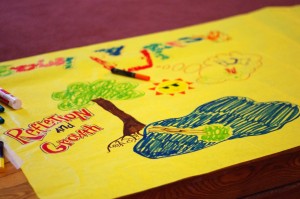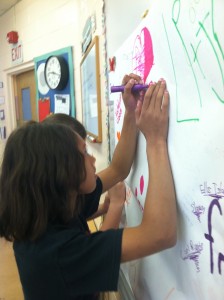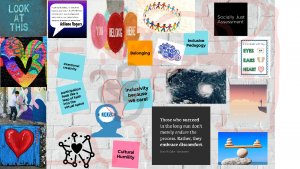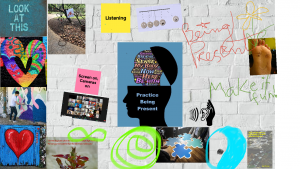Apr 05, 2021 Graffiti Wall for Active and Engaging Reflection Online or In-Person
In my February post, I shared how I have been using my favorite closing reflection activity, “Group Drawing,” online with Jamboard combined with breakout groups (Jamboard is an interactive whiteboard that is part of the Google workspace). Art and creative expression are powerful because they use multiple senses (multiple neuronal pathways), enhance emotional connection, and are participant-centered (see 2018 post on Art and Creative Expression). Graffiti Wall is another of my favorite reflective activities involving co-creative artistic expression. I tend to use Graffiti Wall as a warm-up or “hook to engage” at the beginning of a class or program or as an ongoing reflective tool for participants to add to individually and at their own pace over time.
 Many years ago, Kasey Errico, an educator at Ridge and Valley School, shared this technique with me during one of my workshops, stating that it was a strategy she and her colleagues used before staff meetings to encourage brainstorming around a topic. We used it in my session that day to reflect on participant’s conference experience, and it immediately became a staple in my toolkit. Since that time, I have used it in various group development, teaching, training, and counseling settings for reflection or exploring training or academic themes.
Many years ago, Kasey Errico, an educator at Ridge and Valley School, shared this technique with me during one of my workshops, stating that it was a strategy she and her colleagues used before staff meetings to encourage brainstorming around a topic. We used it in my session that day to reflect on participant’s conference experience, and it immediately became a staple in my toolkit. Since that time, I have used it in various group development, teaching, training, and counseling settings for reflection or exploring training or academic themes.
 In 2011 I shared on this blog an example of using it in a middle school classroom with students who were processing the devastating flood that hit our community right at the start of their school year. See 2011 post.
In 2011 I shared on this blog an example of using it in a middle school classroom with students who were processing the devastating flood that hit our community right at the start of their school year. See 2011 post.
The activity sparked meaningful discussion, reflection and helped the counselors and teachers in the room better understand the trauma students were dealing with and ways the community could support each other.
Facilitation Suggestions for In-Person:
•For in-person groups, I tape large lengths of butcher paper or flip chart paper on an available wall or possibly tables if walls are unavailable.
•As participants enter the classroom or group room space, I invite them to choose their favorite color marker or crayon.
•I set up the activity by asking them to imagine that they are graffiti artists and that this is their can of spray paint. A store owner has given them permission to decorate the wall with graffiti to describe their experiences, thoughts, reflections, questions regarding the theme or reflection topic at hand.
•Invite them to use artwork or words and explain that, like a real wall of graffiti, others can add to or comment on their artwork or musings.
•I often encourage groups to do this silently (probably an unrealistic challenge for middle schoolers, but something that has been helpful when I have facilitated this activity with older groups).
For Online Graffiti Wall:
 First, choose your whiteboard application. I have been using Jamboard as a replacement for my flip chart paper or butcher paper in my in-person groups. There are more sophisticated whiteboards out there, but I find Jamboard simple to use for this purpose.
First, choose your whiteboard application. I have been using Jamboard as a replacement for my flip chart paper or butcher paper in my in-person groups. There are more sophisticated whiteboards out there, but I find Jamboard simple to use for this purpose.- I set the framework up in much the same way. I’ve created a simple template on Jamboard of a blank brick wall that you are welcome to copy (email me I and will send you the image/Jamboard link).
- As participants enter my Zoom room, I share the Graffiti Wall page and the reflection prompt or theme. I often write the reflection prompt in my waiting room message for the group to think about as they enter. Just this week, for a group of educators and counselors I have been working with, I used the prompt: “Thinking about the transition to full-time school in spring of 2021, what does active, meaningful academic engagement and social and emotional learning look like, sound like and feel like? What is helping you inspire and engage your students meaningfully?
- For participants who have never used Jamboard, you can create a practice page and show them the drawing tools, text tools, and image import tools and give them some time to practice.
- With Jamboard, you can save an image of the specific page to share with the group or a PDF of the entire Jamboard. I recommend always saving copies of your templates for future use and saving work regularly and often.
- After the group has spent time adding to the Graffiti Wall (this could be over a short time or possibly over a few sessions or class periods). I divide the group into small breakout groups (see previous article) and invite participants to reflect together on what they see on the wall and what they added.
 Whether online or in-person, I find people will often more readily express their thoughts through imagery rather than by verbal means. When framed intentionally, this activity is non-threatening to those who don’t consider themselves “artists” because they can blend words and images (with online whiteboards, they can even import images and turn them into a collage). Group members can choose their participation level and learn as much from contributing as they do from observing others’ posts. The graffiti becomes an “artifact” of the group’s thoughts and experiences and can jumpstart meaningful dialogue and reflection. I am finding the ease of saving these reflection artifacts is one of the pluses of the online variation.
Whether online or in-person, I find people will often more readily express their thoughts through imagery rather than by verbal means. When framed intentionally, this activity is non-threatening to those who don’t consider themselves “artists” because they can blend words and images (with online whiteboards, they can even import images and turn them into a collage). Group members can choose their participation level and learn as much from contributing as they do from observing others’ posts. The graffiti becomes an “artifact” of the group’s thoughts and experiences and can jumpstart meaningful dialogue and reflection. I am finding the ease of saving these reflection artifacts is one of the pluses of the online variation.
Reference: Thank you to Kasey Errico for the inspiration. This activity is described in both the 2011 Inspired Educator Blog and in Inspired Educator, Inspired Learner book by Jennifer Stanchfield • 2014 Wood N Barnes Publishing.



No Comments